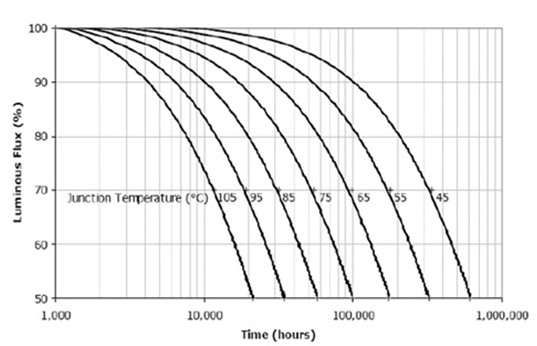Shanghai Longmao Microelectronics Co., Ltd. Â Mao Yuhai
Now everyone is beginning to realize that light decay is the main reason why high-power LED street lights can't work for a long time. It is also beginning to realize that an important way to reduce light decay is to improve its heat dissipation. Despite this, judging from the test results of various street lamps by the Shenzhen Lighting Environmental Management Center, the light decay of most street lamps is still unable to meet the requirements for use. The light decay after 1200 hours of lighting, the best is 8%, the worst is 26%, the average is 14%. According to Cree's test results, when the junction temperature is 105 degrees, 14% of the light decay should be after 6000 hours of operation, and the junction temperature of most street lamps is above 105 degrees.

Figure 1. Cree's LED junction temperature and light decay life test results
Many companies may not agree with this result because they think their radiators are carefully designed. The actual situation may be the same, but the results of the test are not doubtful. What's the problem?
I think that the heat sink may not be designed so badly, but it may be because some street lights are powered by a constant voltage power supply.
But why does the use of a constant voltage power supply cause light decay? It sounds like a bit of a fantasy. But it is actually so serious. Let's start from the beginning!
1. Volt-ampere characteristics of LED
We all know that an LED is a diode, and the most important electrical characteristic of a diode is its volt-ampere characteristics. Figure 2 shows the volt-ampere characteristics of Cree's XLamp 7090XR-E.

Figure 2. Voltammetric characteristics of the XLamp7090XR-E
2. Temperature characteristics of LED volt-ampere characteristics
Although it looks the same as a normal diode, the biggest difference is its temperature characteristics. In fact, the volt-ampere characteristics of all diodes have temperature characteristics, but LEDs require special attention. This is because:
2.1 The operating current of high-power LED is relatively large, 1W is 0.35A, 3-5W is 0.7A, 20W is 1.05A, 30W is 1.75A, and 50W is 3.5A. However, some people may think that the forward current of the rectifier diode may reach such a large value.
2.2 Because the current luminous efficiency of LED is relatively low, most of the input electric power is converted into heat, so its heat is very high. If the radiator is not well done, the junction temperature will rise very high.
2.3 LEDs are different from rectifier diodes. They are not made of a common silicon material, but are made of a special material such as gallium nitride. Therefore, the temperature characteristics of its volt-ampere characteristics are also different from those of general diodes, but are significantly larger than those of general diodes. For example, the volt-ampere characteristic of a typical diode has a temperature characteristic of -2mV/°C, but Cree's XLamp7090XR-E has a volt-ampere characteristic with a temperature characteristic of -4mV/°C, which is twice as large as a normal diode.
3. Problems caused by elevated junction temperatures
3.1 The first thing that comes after the LED junction temperature rises is the reduction in light output.
Editor: China Lighting Network - 芷儿
Flexographic Serviette Printing Machine
Printing Machine,Servietteprintng Machine,4 Color Printing Machine
Syngood Machine Co., Ltd. , http://www.jnprintingmachine.com